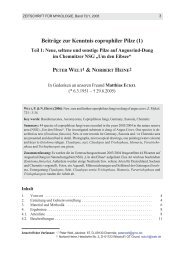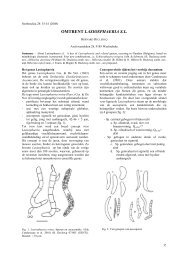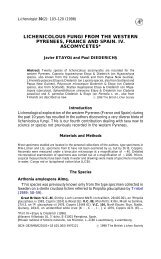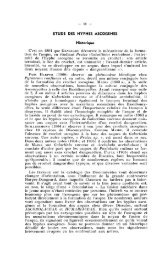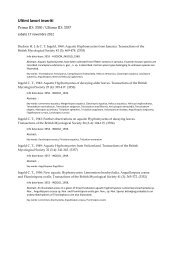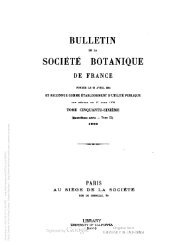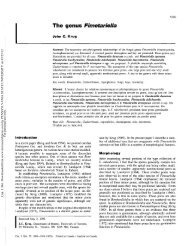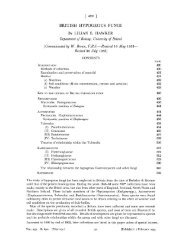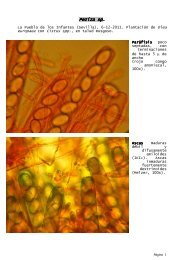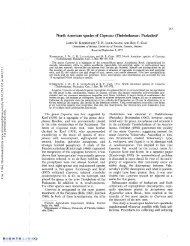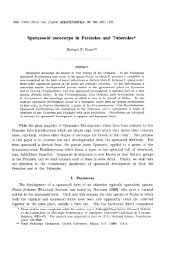NITSCHKIA BROOMEANA - ASCOfrance
NITSCHKIA BROOMEANA - ASCOfrance
NITSCHKIA BROOMEANA - ASCOfrance
Create successful ePaper yourself
Turn your PDF publications into a flip-book with our unique Google optimized e-Paper software.
IMI Descriptions of <strong>NITSCHKIA</strong> <strong>BROOMEANA</strong><br />
Fungi and Bacteria<br />
No. 1739<br />
A. Habit view of cluster of ascomata emerging from bark (bar = 1 mm). B. Detail of four ascomata; note spines (bar<br />
= 0·5 mm). C. Ascomatal wall in vertical section, showing darker outer layer (below, with ‘Munk pores’) and<br />
lighter inner layer (above). D. Upper parts of two asci, showing large number of ascospores in each, arranged in<br />
‘herringbone’ pattern (bar = 10 µm). E. Ascospores. [C–E all at same magnification.]<br />
Nitschkia broomeana (Berk.) Nannf., Svensk Botanisk Tiddskrift 69(1): 60 (1975) [as ‘broomeiana’].<br />
Sphaeria broomeana Berk., Hooker’s Journal of Botany 6: 231 (1854) [as ‘broomeiana’].<br />
Coronophora broomeana (Berk.) Sacc., Sylloge Fungorum 1: 106 (1882) [as ‘broomeiana’].<br />
Fracchiaea broomeana (Berk.) Petch, Annals of the Royal Botanic Garden, Peradeniya 6(4): 333 (1917).<br />
Sphaeria rasa Berk., in J.D. HOOKER, Botany of the Antarctic Voyage of H.M. Discovery Ships Erebus and<br />
Terror, in the years 1839–1843 II. Flora Novae-Zealandia 2(Flowerless Plants, Part 8): 205 (1855).<br />
Fracchiaea rasa (Berk.) Sacc., Sylloge Fungorum 1: 95 (1812).<br />
Sphaeria subcongregata Berk. & M.A. Curtis, in H.W. RAVENEL, Fungi Caroliniani Exsiccati 4: no. 57<br />
(1855) [nom. nud.].<br />
Fracchiaea subcongregata (Berk. & M.A. Curtis) Ellis & Everh., North American Pyrenomycetes: 244<br />
(1892).
Fracchiaea heterogena Sacc., Atti dell’Accademia Scientifica Veneto-Trentino Istriana 2(2): 115 (1873)<br />
[see also p. 163].<br />
Echusias vitis Hazsl., Verhandlungen der Zoologisch-Botanischen Gesellschaft in Wien 23: 367 (1873).<br />
Fracchiaea vitis (Hazsl.) Höhn., Annales Mycologici 17(2–6): 131 (1920).<br />
Cucurbitaria brevibarbata Berk. & M.A. Curtis, in BERKELEY, Grevillea 4(no. 30): 47 (1875).<br />
Fracchiaea brevibarbata (Berk. & M.A. Curtis) Sacc., Sylloge Fungorum 1: 94 (1882).<br />
Sphaeria subconnata Berk. & M.A. Curtis, in BERKELEY, Grevillea 4(no. 32): 141 (1876) [nom. illegit.,<br />
ICBN Art. 53.1, non Schwein., 1832].<br />
Coelosphaeria subconnata (Berk. & M.A. Curtis) Sacc., Sylloge Fungorum 1: 93 (1882).<br />
Fracchiaea subconnata (Berk. & M.A. Curtis) Cooke, Grevillea 15(no. 75): 83 (1887).<br />
Nitschkia subconnata (Berk. & M.A. Curtis) O. Kuntze, Revisio Generum Plantarum 3(2): 501 (1898).<br />
Gibbera moricarpa Cooke, Grevillea 7(no. 42): 51 (1878).<br />
Fracchiaea moricarpa (Cooke) Sacc., Sylloge Fungorum 1: 94 (1882).<br />
Fracchiaea cucurbitarioides Speg., Annales de la Sociedad Científica Argentina 10(1): 16 (1880).<br />
Sphaeria subconvexa Berk. & Ravenel, in M.C. COOKE, Grevillea 15(no. 75): 83 (1887) [nom. nud.].<br />
Fracchiaea americana Berl., Fungi Moricolae 5: 1, fig. V, no. 1, tab. 15, figs 1–6 (1888).<br />
Fracchiaea glomerata Pat., Journal de Botanique 3(10): 168 (1889).<br />
Nitschkia paurida Berk. & M.A. Curtis, in M.C. COOKE, Grevillea 20(no. 96): 107 (1892).<br />
Fracchiaea eucalyptina Berl., Icones Fungorum 3: 27, tab. 35, fig. 1 (1900).<br />
Fracchiaea cucurbitarioides f. eucalyptina (Berl.) Speg., Anales del Museo Nacional de Historia Natural<br />
de Buenos Aires Ser. 3, 19(12): 333 (1909).<br />
Bertiella polyspora Kirschst., Abhandlungen des Botanisches Vereins der Provinz Brandenburg 48: 51<br />
(1906) [fide ERIKSSON & YUE, 1986].<br />
Kirschsteinia polyspora (Kirschst.) Syd., Annales Mycologici 4(5): 455 (1906).<br />
Fracchiaea cucurbitarioides f. pini-insignis Speg., Anales del Museo Nacional de Historia Natural de<br />
Buenos Aires Ser. 3, 19(12): 333 (1909).<br />
Fracchiaea cucurbitarioides f. quercus-sessiliflorae Speg., Anales del Museo Nacional de Historia Natural<br />
de Buenos Aires Ser. 3, 19(12): 334 (1909).<br />
Fracchiaea depressa Petch, Annals of the Royal Botanic Garden Peradeniya 6(3): 221 (1917) [fide<br />
NANNFELDT, 1975].<br />
Colonies as single ascomata or clusters of 2–30 ascomata emerging from cracks in bark or other woody<br />
material, the bark then frequently becoming detached so that the ascomata appear to be superficial.<br />
Ascomata ± globose, only rarely collapsing into a cup-shape, 350–650 µm, often ornamented with pointed<br />
spines up to 25 µm (the spines themselves being sometimes forked and often with secondary barb-like<br />
ornamentation), without an ostiole, but with a short dome-like special opening apparatus (sometimes called<br />
a ‘Quellkörper’); outer wall composed of dark- and thick-walled cells forming a well-defined textura<br />
angularis, individual cells often with small but conspicuous pores which look like minute bullet holes<br />
(sometimes called ‘Munk pores’); inner wall composed of paler, thinner-walled, flatter cells also forming a<br />
textura angularis. Asci arising from the base of the ascoma, oblong to obovate, thin-walled, with only one<br />
wall layer visible with the light microscope, up to 125 × 25 µm, with a short stalk, containing more than 200<br />
ascospores usually characteristically arranged in a ‘herringbone’ pattern. Ascospores colourless,<br />
subcylindrical, slightly curved, smooth, 8–11 × 1·5–2 µm, with one droplet in each end, eventually with a<br />
faint septum. Anamorph not observed. [Description adapted from NANNFELDT (1975).]<br />
DISEASE: None reported.<br />
HOSTS: Plantae: Acer negundo, A. pseudoplatanus (branch), Acer sp.; Aesculus sp.; Ailanthus altissima; Alnus<br />
sp.; Bombax sp. (bark); Butea monosperma (twig); Buxus sp.; Cercis canadensis; Cinchona sp.; Cocos<br />
nucifera; Crataegus sp. (twig); Delonix regia (twig); Dracontomelon sinense; Eucalyptus globulus (bark,<br />
branch), E. lanceolatus (bark), E. viminalis, Eucalyptus sp. (bark); Euphorbia sp. (stem); Ficus religiosa<br />
(twig), Ficus sp. (canker); Fraxinus sp.; Gleditsia triacanthos; Holoptelea integrifolia (twig); Ilex sp.;<br />
Lindera benzoin; Liquidambar styraciflua, Liquidambar sp.; Lonicera sp.; Magnolia virginiana;
Mangifera indica; Mimusops hexandra (stem); Morus rubra, Morus sp.; Myrica sp.; Nyssa sylvatica;<br />
Oogeinia oogeinensis (stem); Persea americana; Pinus strobus, P. sylvestris (cone), P. taeda, Pinus sp.;<br />
Pongamia glabra; Prunus sp.; Pyrus communis, P. malus; Quercus sp.; Rhamnus sp.; Robinia<br />
pseudacacia; Rubus sp.; Salix koreensis, S. nigra; Sambucus canadensis; Sassafras sp.; Schizolobium sp.;<br />
Shorea robusta (stem, wood); Sophora japonica; Tectona grandis (root); Tilia heterophylla var.<br />
michauxii; Ulmus alata; Viburnum grandiflorum, Viburnum sp.; Weinmannia sp. Other associated<br />
organisms: Fungi: Botryosphaeria ribis.<br />
GEOGRAPHICAL DISTRIBUTION: AFRICA: Gambia, Ghana, Malawi, Sierra Leone, Zimbabwe. NORTH<br />
AMERICA: USA (Alabama, Florida, Georgia, Idaho, Louisiana, Nebraska, New Jersey, North Carolina,<br />
Ohio, Oklahoma, South Carolina, Tennessee, Virginia). CENTRAL AMERICA: Guatemala, Nicaragua,<br />
Panama. SOUTH AMERICA: Argentina, Brazil, Venezuela. ASIA: China (Beijing, Fujian, Hebei, Hunan,<br />
Jiangsu, Sichuan, Yunnan, Zheijang), India (Andhra Pradesh, Chhattisgarh, Madhya Pradesh,<br />
Maharashtra), Japan, Korea, Pakistan, Sri Lanka, Taiwan. AUSTRALASIA: Australia (South Australia),<br />
New Zealand. EUROPE: former Czechoslovakia, France, Great Britain, Italy, former Yugoslavia.<br />
INFRASPECIFIC VARIATION: The large number of synonyms, many of which are subspecific in rank,<br />
suggests that there may be some infraspecific variation in this fungus. Slightly larger ascospores have<br />
been observed, for example, in collections from northwest Scotland, than in collections from lower<br />
latitudes.<br />
TRANSMISSION: Ascomata of this species open by irregular apical cracks, but the mode of ascospore release<br />
and transmission is not known.<br />
NOTES: Diagnostic features. Clusters of ascomata ornamented with short spines emerging from bark or<br />
superficial on woody substrata; asci each containing more than 200 ascospores usually arranged in a<br />
characteristic ‘herringbone’ pattern.<br />
NANNFELDT (1975) regarded this species as ‘widespread in most warmer countries’ but thought that in<br />
Europe records ‘from more northern areas are erroneous’. While this may be generally true, several<br />
specimens have been collected on fallen cones of Pinus sylvestris in native woodland in Scotland, but<br />
only in the northwest, where the mild climate and infrequent frosts as a result of the Gulf Stream may be<br />
a significant factor. There, the fungus is never abundant and only very occasionally encountered, but<br />
appears to be native.<br />
Interactions. None reported. Probably saprobic or, like other members of this genus, parasitic on other<br />
fungi.<br />
Conservation status. Records exist from at least 1854 to November 2001, and the species has been<br />
observed from January–June and August–December. In addition to cited literature and internet sources,<br />
this description sheet is based on 19 items in the IMI dried reference collection, 18 records in the<br />
author’s computerized database (11 of which refer to IMI items), 4 records in the Fungal Records<br />
Database for the British Isles (http://194.203.77.76/fieldmycology/), 62 records in the USDA database<br />
(http://nt.ars-grin.gov/fungaldatabases/index.cfm) and 4 specimens in the K fungal reference collection.<br />
This fungus is very widely distributed and rather frequently encountered. The absence of recent records<br />
may be more a reflexion on the decline of field mycologists than an indication of a change in population<br />
status. The species is associated with many different and unrelated plants, many undoubtedly not at risk,<br />
although they may not be the nutrient source if N. broomeana is indeed parasitic on other fungi. There are<br />
no obvious threats. Using IUCN criteria [IUCN SPECIES SURVIVAL COMMISSION (2006). 2006 IUCN Red<br />
List of Threatened Species. . Downloaded on 15 May 2006], the species is<br />
assessed globally as least concern.<br />
LITERATURE: CHEN, C.Y. & HSIEH, W.H. New records of ascomycete for Taiwan. Transactions of the<br />
Mycological Society of the Republic of China 9(1): 1–20 (1994). Chen, M.M. Forest Fungi<br />
Phytogeography Forest Fungi Phytogeography of China, North America, and Siberia and International
Quarantine of Tree Pathogens (Sacramento, CA: Pacific Mushroom Research and Education Center):<br />
469 pp. (2002). COOKE, W.B. The 1979 Oklahoma foray. Mycologia 75: 752–755 (1983). DOIDGE, E.M.<br />
The South African Fungi and Lichens to the End of 1945. Bothalia 5: 1094 pp. (1950). ERIKSSON, O. &<br />
YUE, J.Z. Bertiella (Sacc.) Sacc. & Sydow, a synonym of Massarina Sacc. Mycotaxon 27: 247–253<br />
(1986). FITZPATRICK, H.M. The genus Fracchiaea. Mycologia 16(3): 101–114 (1924). HANLIN, R.T. A<br />
Revision of the Ascomycetes of Georgia. Georgia Agricultural Experiment Station Mimeographed<br />
Series N.S. 175: 65 pp. (1963). HAWARE, M.P., SHARMA, N.D. & JOSHI, L.K. Fungi on Eucalyptus<br />
globulus from Jabalpur. JNKVV Research Journal 10(1): 96–97 (1976). HSIEH, W.H., CHEN, C.Y. &<br />
WANG, C.L. [Taiwan Ascomycetes. Pyrenomycetes and Loculoascomycetes] (Taichung, Taiwan: China<br />
Graphics): 244 pp. (2000). MILLER, J.H. The ascomycetes of Georgia. Plant Disease Reporter<br />
Supplement 131: 31–93 (1941). NAITO, T. The mycoflora of southern Kiusiu IV. Scientific Reports,<br />
Kagoshima University 1: 71–81 (1952). NANNFELDT, J.A. Stray studies in the Coronophorales<br />
(Pyrenomycetes) 4–8. Svensk Botanisk Tidskrift 69(3): 289–335 (1975). RAJAK, R.C. & PANDEY, A.K.<br />
Fungi from Jabalpur – II. Indian Journal of Mycology and Plant Pathology 15: 186–194 (1985).<br />
ROMERO, A.I. Contribución al estudio de los hongos xilófilos de la Argentina. II. Ascomycotina en<br />
Eucalyptus viminalis (Myrtaceae). Darwiniana 28: 251–270 (1987). TENG, S.C. Fungi of China (Ithaca,<br />
NY: Mycotaxon Ltd): xiv, 586 pp. (1996). VIÉGAS, A.P. Alguns Fungos do Brasil. II. Ascomicetos.<br />
Bragantia 4(1–6): 394 (1944).<br />
[Number in brackets, e.g. (62, 5055), refer to abstracts in Review of Plant Pathology]<br />
D.W. Minter<br />
CABI Europe, Egham, UK<br />
Issued by CABI Europe – UK, Bakeham Lane, Egham, Surrey, TW20 9TY, UK<br />
© CAB International, 2007. All rights reserved.<br />
No part of this publication may be reproduced in any form or by any means, electronically, mechanically, by<br />
photocopying, recording or otherwise, without the prior permission of the copyright owner.



